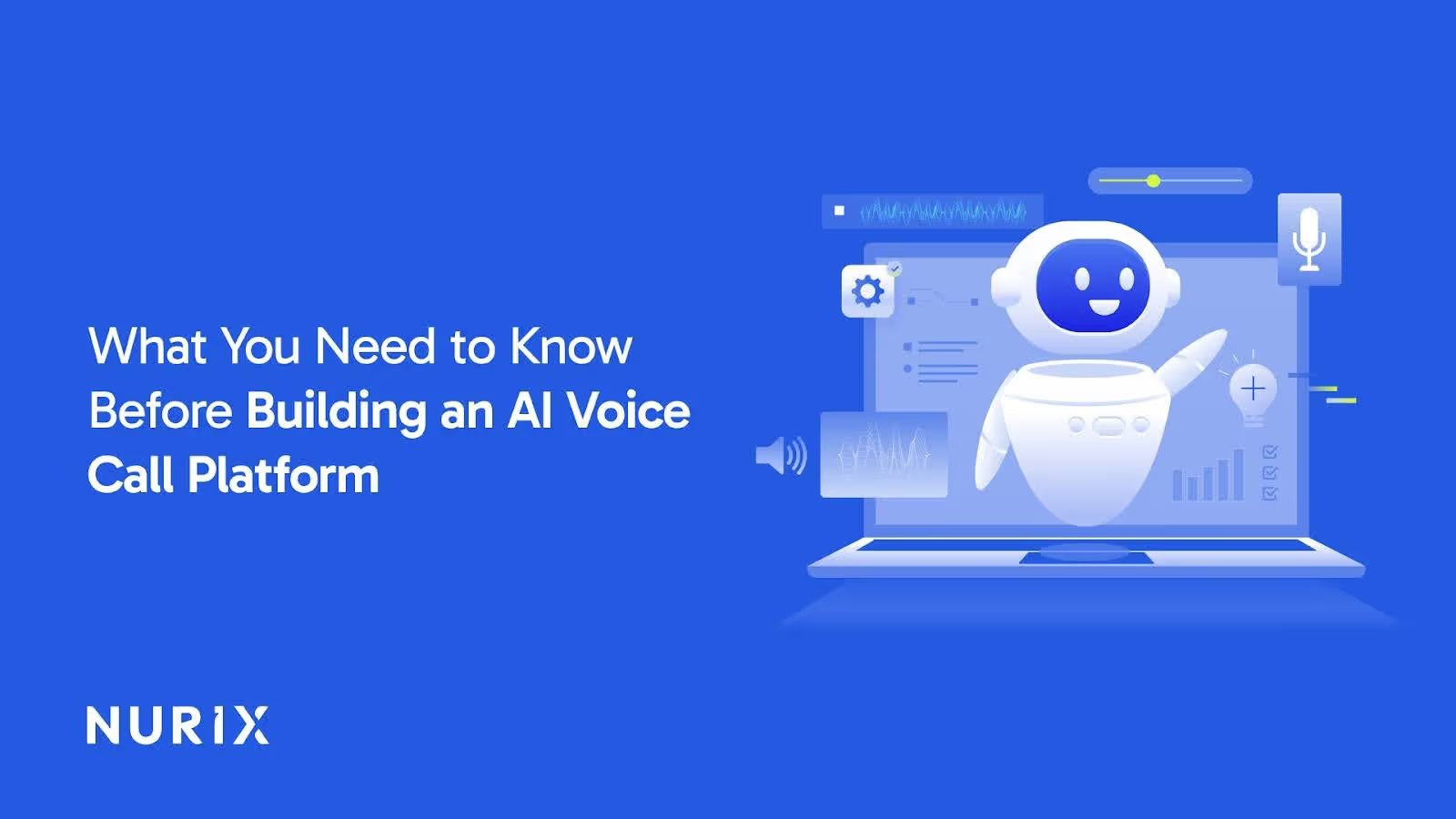What if the technology you choose today could change the way your business connects with customers and teams for good? Building an AI voice call platform is more than just a technical project, it’s an opportunity to address real communication challenges that slow companies down.
Many businesses jump into AI solutions hoping for quick wins, only to discover the hidden complexities of integration, scalability, and user experience. Albert Einstein’s advice comes to mind, if you can’t explain something simply, you probably don’t fully understand it yet. The same is true for AI voice calls, making them work smoothly takes thoughtful planning and smart execution.
The real aim isn’t just to add AI to your toolkit, but to create a system that makes every conversation better, reduces costs, and leaves people feeling heard. Still, the process can be trickier than it first appears. With so many technologies to choose from, even experienced teams can feel overwhelmed trying to fit new solutions into old systems.
This guide walks through what really matters when building an AI voice call platform. Whether you want to improve customer support, make your team more efficient, or offer more personal experiences, you’ll find practical steps to help you create a platform that truly delivers
What Are AI Calls?
AI calls are phone conversations powered by artificial intelligence, but they go far beyond what traditional automated calls can do. Instead of just following a script, these platforms listen, understand, and respond in real time using voice recognition and natural language processing. This lets them handle questions, automate routine tasks, and adapt to each caller’s needs, making every interaction feel more personal and effective.
Key Benefits of AI Calls
AI calls are setting a new standard for customer conversations, combining speed and intelligence to improve support, cut costs, and create more meaningful experiences, backed by real evidence and growing adoption across industries
- Increased First Call Resolution (FCR) Rates: AI improves FCR by providing agents with real-time, context-aware guidance, reducing callbacks, and boosting customer satisfaction. AI solutions can increase FCR by up to 5%.
- Reduced Average Handling Time (AHT): AI streamlines call workflows by automating repetitive tasks and ensuring intelligent call routing, reducing AHT.
- Improved Call Routing with Sentiment and Intent Analysis: AI dynamically interprets caller intent and emotional tone, prioritizing high-impact issues and reducing call abandonment rates.
- 24/7 Scalability with Consistent Quality: AI enables businesses to handle massive call volumes without service degradation. AI is expected to handle up to 95% of all customer interactions by 2025.
- Real-Time Agent Assistance and Coaching: AI provides agents with live prompts, call scripts, and compliance reminders, boosting confidence and reducing errors.
- Data-Driven Insights for Continuous Improvement: AI captures and analyzes call data, revealing patterns in customer behavior and agent performance, enabling optimized staffing and training.
- Cost Savings and Productivity Gains: AI automates routine tasks, reducing the need for large call center teams and lowering operational expenses. AI can triple agent productivity and cut costs.
- Improved Customer Satisfaction and Loyalty: AI personalizes interactions based on customer history and preferences, leading to more meaningful conversations and faster resolutions.
Behind every AI call is a mix of technology and real conversation, changing the way we talk and connect. This opens the door to a deeper look at what makes AI voice call platforms tick, and how they’re built to deliver meaningful interactions.
If you’re curious about the upsides and challenges of customer support automation, this blog breaks down the pros and cons in detail. Click here to know more!
Core Features of AI Voice Call Platforms
AI voice call platforms tackle the everyday frustrations of traditional call centers, like unpredictable service, long waits, and limited staff, by building in features that change how conversations start, unfold, and end.
Instead of just automating old routines, these platforms bring together technology that truly understands people, making every call smoother and more valuable for both customers and teams.
- High-Accuracy, Domain-Adaptive Speech Recognition: Advanced deep learning models enable precise transcription across accents and noisy environments, with custom vocabulary customized to industry-specific terms, minimizing errors in critical conversations.
- Natural Language Understanding (NLU) with Contextual Awareness: AI interprets caller intent and manages multi-turn dialogues, enabling fluid, human-like interactions for complex tasks beyond scripted responses.
- Real-Time Sentiment and Emotion Detection: Analyzes caller tone to prioritize urgent or frustrated callers, improving routing efficiency and reducing abandonment rates.
- Smooth Telephony and CRM Integration: Out-of-the-box connectivity with telephony and CRM systems ensures automatic call logging, contextual data access, and streamlined agent workflows.
- Natural, Human-Like Voice Synthesis: Voice agents deliver lifelike speech with adaptive pacing and brand-consistent voice cloning, improving engagement and trust.
- Real-Time Agent Assistance and Compliance Monitoring: Live prompts and compliance alerts support agents during calls, reducing errors and ensuring regulatory adherence.
- Omnichannel Support with Unified Interaction Management: Unified handling of calls, chat, email, and social media ensures a consistent customer experience across all channels.
- Scalable, Low-Latency Cloud Infrastructure: Global cloud networks provide reliable, real-time voice communication worldwide, critical for remote and global operations.
- Comprehensive Analytics and Automated Call Summaries: Detailed insights on sentiment, agent performance, and call outcomes enable continuous optimization and informed decision-making.
The features that make AI voice call platforms work so well are built on a foundation of thoughtful design and careful execution. Understanding what’s involved helps bring clarity to the process, so let’s walk through the key steps needed to bring an AI voice call platform to life.
How to Build an AI Voice Call Platform
Building an AI voice call platform is about much more than just writing code; it means thinking through how people talk, how data moves in real time, and how every user will experience the system. While the process can’t be rushed, taking the right steps at each stage will help you stay focused on what matters most: making calls smarter, smoother, and more helpful for everyone involved
1. Use a Unified Conversational Architecture
- Modern AI voice platforms integrate three core components, speech-to-text (ASR), language understanding (NLU/LLM), and text-to-speech (TTS), within a unified infrastructure rather than isolated APIs.
- This cohesion ensures low latency, natural conversational flow, and reliable performance across diverse accents and noisy environments.
2. Design for Real-Time, Context-Aware Interactions
- Beyond transcription, the platform must understand caller intent, maintain conversation context, and execute business logic dynamically.
- This enables multi-turn dialogues, personalized responses, and decision-making such as escalation or triggering backend actions during calls.
3. Integrate Deeply with Backend Systems
- The AI agent should connect smoothly with CRMs, ticketing platforms, e-commerce engines, and knowledge bases via APIs and webhooks.
- This integration allows live data retrieval, real-time updates to customer records, and personalized interactions that reflect up-to-date business information.
4. Support Telephony Standards and Infrastructure
- Ensure compatibility with VoIP, PBX, and SIP trunking protocols to maintain high call quality and reliable connectivity.
- Platforms with programmable voice APIs and global low-latency networks (e.g., Telnyx) provide scalable, real-time voice call handling essential for production-grade deployments.
5. Enable Developer Flexibility and Rapid Iteration
- Choose platforms like Nurix AI offering transparent APIs and programmable workflows that empower developers to build, test, and deploy AI voice agents quickly.
- This agility supports fast experimentation, customization, and continuous improvement based on real-world feedback.
6. Implement Stong Monitoring and Analytics
- Incorporate real-time monitoring of call quality, agent performance, sentiment analysis, and key metrics.
- Analytics dashboards enable data-driven optimization, helping teams identify bottlenecks, improve scripts, and improve customer experience over time.
7. Plan for Ongoing Maintenance and Updates
- AI voice agents must evolve alongside your business. Regularly update training data, conversation flows, and integrations to reflect product launches, policy changes, and customer feedback.
- Neglecting this leads to outdated or incorrect information being conveyed.
Building and launching an AI voice call platform can be complex, but the right partnership makes all the difference. That’s where Nurix AI comes in, helping businesses move through the challenges smoothly and bring their vision to life with confidence
Why Nurix AI is a Great Choice for AI Calls
Nurix AI creates generative AI solutions that smoothly integrate AI efficiency with human oversight, improving both enterprise workflows and customer interactions. Their proprietary low-latency voice stack delivers smooth, human-like interactions with support for barge-in, real-time responses, and natural dialogue.
By employing advanced techniques such as retrieval-augmented generation (RAG), they ensure responses are accurate, context-aware, and grounded in specific enterprise needs.
Key Features
- Proprietary Low-Latency Voice Stack: Delivers smooth, human-like interactions with support for barge-in, real-time responses, and natural dialogue that keeps customers engaged and satisfied
- Advanced RAG Technology: Employs retrieval-augmented generation (RAG) to ensure responses are accurate, context-aware, and grounded in the specific needs of each enterprise
- Extensive Integration Library: 300+ pre-built integrations with existing CRM, telephony, CCaaS, and internal systems or knowledge bases, ensuring AI agents fit right into workflows without complex setups
- Human-AI Hybrid Approach: Focuses on AI-powered automation while maintaining a high level of personalized customer service at scale, combining AI efficiency with human oversight
- Expert Engineering Team: Team composed of engineers from the world's leading tech companies and top educational institutions, driving innovative capabilities and cutting-edge AI solutions
- Enterprise-Grade Scalability: Features include workflow automation and management, product building, performance monitoring and maintenance, platform design and development
- Rapid Implementation: Instant integration capabilities with no complex setups required, allowing businesses to deploy AI agents quickly into existing workflows
Conclusion
Building an AI voice call platform is far from straightforward. It means paying close attention to your business’s specific needs, choosing the right technology, and planning for the platform to adapt as your company grows. True success comes when the platform solves real problems, makes customer conversations better, and helps your team work more efficiently.
Businesses that invest the time and care to thoughtfully implement AI voice calls will be ready to handle the ever-changing expectations of customer communication. The real win is building a platform that doesn’t just work, it makes every interaction count. As customer service evolves, those who embrace this change will set themselves apart.
Ready to transform the way you connect? Discover how Nurix AI can simplify your AI call experience, offering improved precision, smooth integration, and improved communication capabilities. Get in touch with us!
FAQs about AI calls
1. Why is latency such a critical challenge in AI voice calls?
Latency affects how quickly an AI can respond during a conversation. Delays beyond half a second can disrupt the natural flow, causing frustration and reducing the perceived usefulness of the system.
2. Can AI voice calls handle interruptions or overlapping speech effectively?
Many AI systems struggle with detecting when a speaker starts or stops, especially with interruptions or disfluencies like stutters. This makes managing natural conversation flow a technical hurdle.
3. How do AI voice calls adapt to different languages and dialects?
Using a one-size-fits-all framework often fails because voice recognition accuracy varies widely across languages and accents. Effective platforms must support multiple versions to handle diverse linguistic needs and regulatory requirements.
4. What are the privacy concerns unique to AI voice calls?
Collecting and processing voice data raises complex privacy issues. Businesses must go through data protection laws carefully to avoid legal risks and maintain customer trust.
5. Why is emotional nuance difficult for AI voice calls to grasp?
AI can detect basic tones but often misses layered emotions like sarcasm or hesitation, which can lead to misinterpretation and less satisfying interactions.










